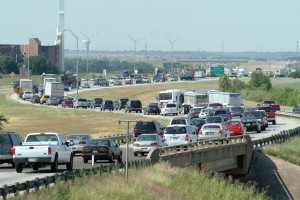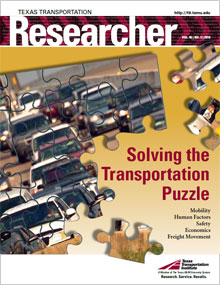
Gone are the days when we simply build new roads or more lanes to ease traffic congestion. Funding is limited, and — in many areas — the space is no longer available. As a result, there’s been a shift from building new highways to managing the roads we have. Mobility analysts examine problems associated with congestion and develop innovative solutions and measure their effectiveness.
Texas Transportation Institute (TTI) Research Engineer Tim Lomax is well known for his three decades of research measuring congestion and reporting the results in TTI‘s Urban Mobility Report. Lomax’s work looks at long-term congestion trends, ranks the largest 100 metropolitan areas (in terms of delay, congestion cost and excess fuel consumed) and describes congestion improvement strategies.
“Since virtually everyone is impacted by congestion, the research we do has a lot of built-in interest,” Lomax says. “But there’s a lot more to it than just measuring the time commuters spend in traffic.”
As congestion worsened over the last several decades, innovative strategies have been developed, implemented and measured. Some of the early strategies were as simple as timing the signal lights on arterial roadways. High-occupancy vehicle (HOV) lanes were implemented to help relieve congested roadways. Although successful in incentivizing carpooling and transit use, many of the nation’s HOV lanes have also become crowded.
Pay As You Go
TTI Senior Research Engineer Ginger Goodin, an expert in the field of road pricing, is the principal investigator on a Federal Highway Administration project that developed a toolkit of resources for use in evaluating the need for and implementing high-occupancy toll (HOT) lanes. And along with TTI Senior Research Engineer Beverly Kuhn and other researchers, Goodin also co-authored a handbook on managed lanes. The handbook was part of a multiyear effort to assist the Texas Department of Transportation (TxDOT) in optimizing the performance of managed-lane facilities.
“What we see happening now is the growing acceptability of paying for a predictable trip,” says Goodin. “HOT lanes and managed lanes are in place in about a dozen U.S. cities, and more are being developed.”
Goodin points out that there is growing interest in pricing applied to new roads, new bridges and new lanes, both for purposes of funding the improvements and managing the flow of traffic.
Not Just an Urban Problem
The mobility challenges facing rural communities have concerned transportation officials since the 1920s. Today, the rapid growth of many urban and suburban communities extends to the areas once known as rural, altering traffic patterns and changing local and regional economies.
TTI Associate Research Scientist John Overman examined the different approaches used by transportation planners during the development of a rural transportation system. The result of the study was a comprehensive guidebook that presented tools and strategies for planning practitioners, TxDOT engineers, administrators and transportation planning partners to address their specific transportation needs.
Overman is currently finishing a project examining the role of rural planning organizations (RPOs) in the mobility planning and programming process in rural areas of Texas. As the state seeks to improve rural mobility, RPOs will play an increasing role as forums for informed transportation decision making. Overman’s project will produce a guidebook for TxDOT districts that currently lead rural transportation planning.
Technology to the Rescue?
Technology advancements are improving the nation’s commute. For years, traffic management centers have used closed-circuit television, traffic sensors, electronic message signs and ramp meters to monitor and manage traffic. Now, many private-sector companies provide real-time traffic information based on Global Positioning System devices, included in phones and navigation devices, which help monitor the speed of traffic and point to trouble areas in the roadway network.
“With improving computer technology, more commuters are able to work from home at least part of the time,” says TTI Associate Research Scientist David Schrank. Virtual home offices — utilizing the Internet, e-mail and teleconferencing — could also be a part of the solution in the future to help ease traffic congestion and save fuel.
Commentary on Mobility
Ken Allen
Senior Vice President of Supply Chain and Logistics
H-E-B
Time is money. That statement has never been truer for business than it is today. We define transportation “mobility” as a performance measure for how we move people and products. That might involve the impact on a company’s bottom line or a parent’s lost quality time with a child. Wasted gasoline, wasted time, declining air quality — all are signs that mobility is decreasing and congestion worsening. Time isn’t just money…it can also be quality of life or the very air we breathe.
Texas is growing, with an expected population of over 30 million by 2030. Our transportation infrastructure isn’t keeping up. “Learning to do better with what we have” is as much a moral imperative as a strategy these days. We simply can’t build our way out of transportation problems anymore.
Figuring out how to improve mobility is one way to do better with what we have. The Texas Transportation Institute’s (TTI‘s) expertise in this area helps businessmen like me look ahead so we can better meet our customers’ needs. Not much is more important to a business than a clear picture of what’s to come.
Beyond its internationally recognized Urban Mobility Report, TTI has contributed to improving mobility in other ways. For example, improved safety through roadside devices means smoother traffic flow. That’s important to me in a just-in-time world because I have to get perishable goods to my stores in a timely manner. I’ll lose customers if they have to stare at an empty shelf and ask, “Where’s my milk?” TTI helps me keep from having to answer that question.
We speak of Texas transportation costs in billions of dollars. Even though it’s sometimes not as easy to quantify, we shouldn’t lose sight of just how much TTI contributes to our state’s fiscal well-being.
The 2010-2011 Texas transportation budget — $17.1 billion.
The estimated cost of Texas transportation needs by 2030 — $315 billion.
The value of TTI research — priceless.
